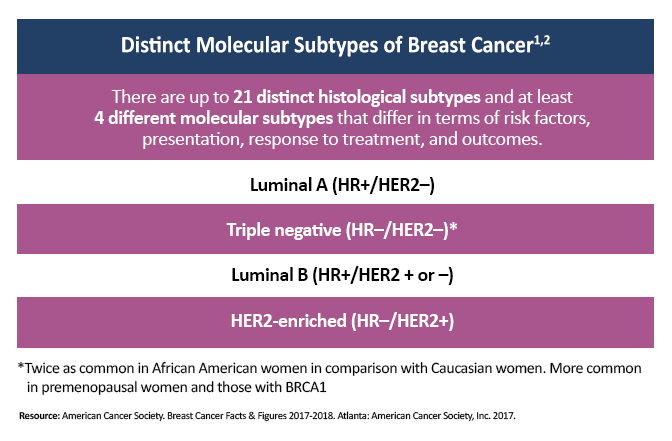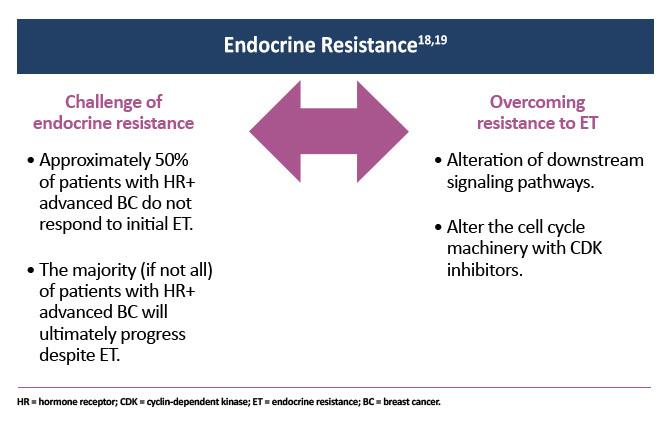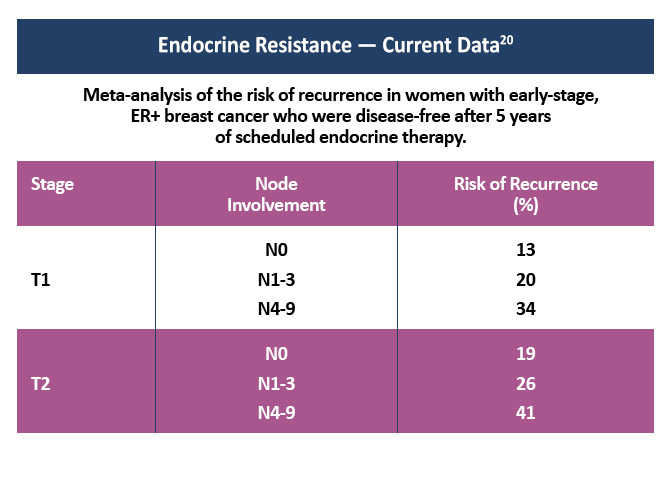Pathophysiology
Breast cancer is a heterogeneous disease consisting of several molecular subtypes, each associated with variations in treatment response and disease-specific outcomes. Current treatment guidelines support the use of molecular analysis to identify these molecular subtypes for use in risk stratification and treatment planning. Decision-making for individual patients must take into account several factors, such as tumor morphology, grade classification, tumor size, presence of lymph-node metastases, and expression of receptors (eg, estrogen, progesterone, and human epidermal growth factor receptor 2 [HER2]). It is crucial that clinicians understand the impact of cell-cycle dysregulation and the molecular subtypes of breast cancer on treatment selection in order to better personalize therapy regimens and improve patient outcomes.1

Cell-Cycle Regulation
Actively dividing cells pass through a series of stages called the cell cycle as they grow and duplicate their deoxyribonucleic acid (DNA) in preparation for division. When the cell receives mitogenic signals prompting cell division, the cell progresses from the gap 1 (G1) phase into the synthesis (S) phase where genetic material is copied. If the genetic material is duplicated correctly, the cell moves into the gap 2 (G2) phase and prepares for mitosis (M phase), the physical division of one cell into two identical daughter cells.3
The proteins that drive the progression of the cell cycle are cyclin-dependent kinases (CDKs). CDKs are found in inactive conformations in the cell until they are bound to cyclins, which are small regulatory proteins that undergo a constant cycle of synthesis and degradation as the cell cycle progresses. When activated by cyclins, CDKs phosphorylate key substrates in cell-signaling cascades to promote DNA synthesis and mitosis.3
The term “cell-cycle checkpoint” refers to mechanisms by which the cell actively halts progression of the cell cycle until it can ensure that an earlier phase of the cycle is complete. Checkpoints have been identified in G1 and G2 that confirm that the cell is large enough for division, within the S phase to check for proper DNA replication, and in the M phase to ensure mitotic spindles are attached to sister chromatids.3 Unlike normal cells that only divide when they receive stimulatory mitogenic signals, cancer cells exhibit unchecked proliferation.4 Cancer cells often lose control of the cell cycle through mutations that knock out regulatory genes. Although proto-oncogenes normally encourage cell growth and division, if mutated, they become overactive oncogenes, leading to unregulated cell proliferation. Tumor suppressor genes, such as retinoblastoma (Rb) protein, normally inhibit cell division, promote apoptosis, or repair DNA replication errors; however, they lose their inhibitory ability when mutated and promote cell proliferation.
Receptor Status and Endocrine Therapies
Human epidermal growth factor receptor 2 (HER2; also called HER2/neu or ErbB2) is a membrane tyrosine kinase and an oncogene. Activation of HER2 increases the activity of transcription factors necessary for regulation of genes involved in cell proliferation, survival, differentiation, angiogenesis, invasion, and metastasis.5 Over-amplification of HER2 hyperactivates components of the cell-cycle machinery, producing a potent proliferative and anti-apoptosis signal. HER2 is overexpressed in 20–30% of breast cancers, and this overexpression is associated with resistance to chemotherapy and poor patient prognosis.6
Approximately 75% of women with breast cancer have hormone receptor-positive (HR+) disease, defined as a cancer cell with estrogen receptors (ERs) and/or progesterone receptors (PRs).7,8 Estrogen signaling via the ER is essential for cellular proliferation of normal mammary tissue.9 Estrogen withdrawal, resulting from antiestrogen therapy, leads to inhibition of ER signaling and ultimately to cell death through cell-cycle arrest.10,11 Over the past several decades, antihormonal endocrine agents have emerged as the preferred first-line therapy for HR+ disease.12,13 These agents consist of drugs spanning three classes: selective estrogen receptor modulators (SERMs, eg, tamoxifen) that block the activity of the ER; estrogen synthesis inhibitors (eg, aromatase inhibitors, including anastrozole, letrozole, and exemestane); and selective estrogen receptor downregulators (SERDs, eg, fulvestrant) that induce destabilization and degradation of ERs.14
Despite the initial effectiveness of endocrine therapy, endocrine resistance continues to be an important clinical challenge in the management of breast cancer.15 About 25% of patients who present with HR+ early stage disease will develop resistance within the first 10 years after diagnosis, manifested as recurrences either during or after adjuvant endocrine treatments.16 In the metastatic setting, endocrine therapy leads to initial tumor regression in approximately 30% of patients; however, resistant disease ultimately develops in almost all patients with metastatic disease, driving disease progression and eventually resulting in death.17 

Targeting Cell-Cycle Dysregulation in Cancer
In vitro evidence suggests that hormone receptor-positive (HR+) breast cancer that has developed resistance to endocrine therapies remains dependent on cyclin-dependent kinase 4 (CDK4)-cyclin D1 to promote cell proliferation. Cyclin D1 is a regulatory molecule in the cell cycle that binds to and activates CDK4 and CDK6. These activated kinases promote cell-cycle entry by phosphorylating and inactivating the retinoblastoma (Rb) tumor-suppressor protein. The Rb protein is normally bound to E2F transcription factors, preventing them from expressing genes needed to advance the cell cycle. By inactivating Rb, CDK4 and CDK6 release the inhibitory signaling of Rb on E2F transcription factors, initiating a signaling cascade that promotes the transition from the gap 1 (G1) phase of the cell cycle to the deoxyribonucleic acid (DNA)-synthesis (S) phase.21 Cyclin D1 is overexpressed in 40% of breast cancers; this aberrant overexpression may allow breast cancer cells to divide in the absence of mitogenic signals, leading to the development of a tumor.6
CDK4/6 inhibitors have emerged as a powerful class of targeted agents against breast cancer. CDK4/6 inhibitors cause cell-cycle arrest by preventing the activation of CDK4/6 kinases. Without CDK4/6 activation, the tumor suppressor protein Rb remains tightly bound to E2F transcription factors, and genes required for DNA replication are not transcribed. There are currently 3 agents in this therapeutic class of drugs: abemaciclib, palbociclib, and ribociclib.22
The combination of any of the three CDK 4/6 inhibitors with anti-estrogen therapy in patients with HR+/ human epidermal growth factor receptor 2 (HER2)-negative advanced/metastatic breast cancer has demonstrated superiority to anti-estrogen therapy alone across multiple patient subtypes, regardless of a patient’s age, performance status, menopausal status, extent of disease, or race. Knowledge of the clinical trials data, including dosing, side-effect management, study endpoints, and required monitoring in addition to patient population characteristics are considerations that will be factors in choosing which of these potent agents to use in this difficult to treat malignancy.
| Available CDK4/6 Inhibitors23–25 | |||
| Palbociclib | Ribociclib | Abemaciclib | |
|
Dosing schedule |
125 mg once daily taken with food for 21 days followed by 7 days off treatment | 600 mg once daily with or without food for 21 days followed by 7 days off treatment |
150 mg twice daily with or without food in combination with an endocrine-based therapy
200 mg twice daily when used as monotherapy |
| FDA-approved indications for advanced or metastatic HR+/HER2– breast cancer |
• Use with an aromatase inhibitor as initial endocrine-based therapy in postmenopausal women or in men
• Use with fulvestrant in patients with disease progression following endocrine therapy |
• Use with an aromatase inhibitor in pre/perimenopausal or postmenopausal women as an initial endocrine-based therapy
• Use with fulvestrant in postmenopausal women as initial endocrine-based therapy or following disease progression on endocrine therapy |
• Use with an aromatase inhibitor as initial endocrine-based therapy in postmenopausal women
• Use with fulvestrant in women with disease progression following endocrine therapy
• Use as monotherapy in adults with disease progression following endocrine therapy and prior chemotherapy in the metastatic setting |
| Most common adverse reactions | (Incidence ≥10%) Neutropenia, infections, leukopenia, fatigue, nausea, stomatitis, anemia, alopecia, diarrhea, vomiting, thrombocytopenia, rash, decreased appetite, asthenia, pyrexia | (Incidence ≥20%) Neutropenia, nausea, infections, fatigue, diarrhea, leukopenia, vomiting, alopecia, headache, constipation, rash, cough | (Incidence ≥20%) Diarrhea, neutropenia, nausea, abdominal pain, infections, fatigue, anemia, leukopenia, decreased appetite, vomiting, headache, alopecia, thrombocytopenia |
| Warnings and precautions | Neutropenia, interstitial lung disease/pneumonitis, embryo-fetal toxicity | Interstitial lung disease/pneumonitis, QT interval prolongation, increased QT prolongation with concomitant tamoxifen, hepatobiliary toxicity, neutropenia, embryo-fetal toxicity | Diarrhea, neutropenia, interstitial lung disease/pneumonitis, hepatotoxicity, venous thromboembolism, embryo-fetal toxicity |
Clinical Trial Data on CDK4/6 Inhibitors in HR+/HER2- Advanced or Metastatic Breast Cancer
Cyclin-dependent kinase 4 and 6 (CDK4/6) inhibitors have shown benefit in women with hormone receptor-positive/human epidermal growth factor receptor-negative (HR+/HER2–) advanced or metastatic breast cancer. Three agents have been approved in combination with endocrine-based therapy or as monotherapy in this patient population.
In phase 3 clinical trials, abemaciclib plus anti-estrogen therapies showed improved progression-free survival (PFS) over endocrine therapy alone. In the MONARCH-2 trial, abemaciclib plus fulvestrant increased median PFS (16.4 months) when compared with fulvestrant monotherapy (9.3 months) in premenopausal and postmenopausal women who progressed on endocrine therapy.26 The MONARCH-3 trial found that abemaciclib plus letrozole or anastrozole improved median PFS over endocrine-based therapy alone as first-line treatment in postmenopausal women with metastatic breast cancer (hazard ratio [HR] = 0.54; P=.000021).27 In the MONARCH-1 trial, an objective response rate of 19.7% and a clinical benefit rate (complete response + partial response + stable disease ≥6 months) of 42.4% were observed with abemaciclib monotherapy in women with metastatic disease who had progressed on or after prior endocrine therapy and had one or two chemotherapy regimens in the metastatic setting.28
The efficacy and safety of palbociclib was evaluated in several large clinical trials. The PALOMA-2 trial showed improved PFS for palbociclib plus letrozole over letrozole alone in postmenopausal women with previously untreated HR+/HER2– advanced breast cancer.29 The PALOMA-3 trial investigated the combination of palbociclib plus fulvestrant versus placebo plus fulvestrant in pre- and postmenopausal women with HR+/HER2– advanced breast cancer who had progressed during previous endocrine therapy. Patients on combination therapy had a significantly longer PFS than patients on endocrine monotherapy (HR = 0.46; P <.0001).30
The MONALEESA-2 trial evaluated the efficacy of ribociclib plus letrozole versus letrozole monotherapy in treatment-naïve postmenopausal women with HR+/HER2– advanced breast cancer. The MONALEESA-7 trial investigated ribociclib plus goserelin versus placebo plus goserelin, with both groups also receiving either tamoxifen or a non-steroidal aromatase inhibitor (letrozole or anastrozole) in premenopausal women. Ribociclib plus endocrine therapy showed significantly improved PFS in both studies.31,32 In MONALEESSA-3, ribociclib plus fulvestrant significantly increased median PFS compared with placebo plus fulvestrant in postmenopausal women with advanced cancer who were treatment naïve or had received up to one line of prior endocrine therapy in the advanced setting (HR = 0.593; P <.001).33


REFERENCES
- Fragomeni SM, Sciallis A, Jeruss JS. Molecular subtypes and local-regional control of breast cancer. Surg Oncol Clin N Am. 2018;27:95-120. Available at ncbi.nlm.nih.gov/pmc/articles/PMC5715810/pdf/nihms899872.pdf
- American Cancer Society. Breast Cancer Facts and Figures 2019–2020. Available at cancer.org/content/dam/cancer-org/research/cancer-facts-and-statistics/breast-cancer-facts-and-figures/breast-cancer-facts-and-figures-2019-2020.pdf. Accessed December 9, 2019.
- Barnum KJ, O’Connell MJ. Cell cycle regulation by checkpoints. Methods Mol Biol. 2014;1170:29-40. Available at ncbi.nlm.nih.gov/pmc/articles/PMC4990352/pdf/nihms734418.pdf
- Deshpande A, Sicinski P, Hinds PW. Cyclins and cdks in development and cancer: a perspective. 2005;24:2909-2915. Available at www.nature.com/articles/1208618.pdf
- Gutierrez C, Schiff R. HER2: biology, detection, and clinical implications. Arch Pathol Lab Med. 2011;135:55-62. Available at archivesofpathology.org/doi/pdf/10.1043/2010-0454-RAR.1
- Harari D, Yarden Y. Molecular mechanisms underlying ErbB2/HER2 action in breast cancer. 2000;19:6102-6114. Available at www.nature.com/articles/1203973.pdf
- Anderson WF, Chatterjee N, Ershler WB, Brawley OW. Estrogen receptor breast cancer phenotypes in the Surveillance, Epidemiology, and End Results database. Breast Cancer Res Treat. 2002;76:27-36. Abstract at ncbi.nlm.nih.gov/pubmed/?term=anderson+wf%5B1au%5D+AND+2002%5Bdp%5D+AND+27-
- Nadji M, Gomez-Fernandez C, Ganjei-Azar P, Morales AR. Immunohistochemistry of estrogen and progesterone receptors reconsidered: experience with 5,993 breast cancers. Am J Clin Pathol. 2005;123:21-27. Available at https://academic.oup.com/ajcp/article/123/1/21/1759394
- Sherr CJ. D-type cyclins. Trends Biochem Sci. 1995;20:187-190. Abstract at ncbi.nlm.nih.gov/pubmed/?term=sherr%5B1au%5D+AND+1995%5Bdp%5D+AND+187-
- Carroll JS, Prall OW, Musgrove EA, Sutherland RL. A pure estrogen antagonist inhibits cyclin E-Cdk2 activity in MCF-7 breast cancer cells and induces accumulation of p130-E2F4 complexes characteristic of quiescence. J Biol Chem. 2000;275:38221-38229. Available at jbc.org/content/275/49/38221.full.pdf
- Sutherland RL, Green MD, Hall RE, et al. Tamoxifen induces accumulation of MCF 7 human mammary carcinoma cells in the G0/G1 phase of the cell cycle. Eur J Cancer Clin Oncol. 1983;19:615-621. Abstract at ncbi.nlm.nih.gov/pubmed/?term=sutherland%5B1au%5D+AND+1983%5Bdp%5D+AND+615-
- Murphy CG, Dickler MN. Endocrine resistance in hormone-responsive breast cancer: mechanisms and therapeutic strategies. Endocr Relat Cancer. 2016;23:R337-R352. Available at https://erc.bioscientifica.com/view/journals/erc/23/8/R337.xml
- Osborne CK. Tamoxifen in the treatment of breast cancer. N Engl J Med. 1998;339:1609-1618. Available at nejm.org/doi/full/10.1056/NEJM199811263392207?url_ver=Z39.88-2003&rfr_id=ori:rid:crossref.org&rfr_dat=cr_pub%3dpubmed
- Garcia-Becerra R, Santos N, Diaz L, Camacho J. Mechanisms of resistance to endocrine therapy in breast cancer: focus on signaling pathways, miRNAs and genetically based resistance. Int J Mol Sci. 2012;14:108-145. Available at mdpi.com/1422-0067/14/1/108
- Williams N, Harris LN. The renaissance of endocrine therapy in breast cancer. Curr Opin ObstetGynecol. 2014;26:41-47. Abstract at ncbi.nlm.nih.gov/pubmed/?term=williams+n%5B1au%5D+AND+2014%5Bdp%5D+AND+41-
- Early Breast Cancer Trialists’ Collaborative Group (EBCTCG). Effects of chemotherapy and hormonal therapy for early breast cancer on recurrence and 15-year survival: an overview of the randomised trials. 2005;365:1687-1717. Abstract at www.ncbi.nlm.nih.gov/pubmed/?term=Lancet%5Bta%5D+AND+2005%5Bdp%5D+AND+1687-
- Jeselsohn R, De Angelis C, Brown M, Schiff R. The evolving role of the estrogen receptor mutations in endocrine therapy-resistant breast cancer. Curr Oncol Rep. 2017;19:35. Abstract at ncbi.nlm.nih.gov/pubmed/?term=jeselsohn%5B1au%5D+AND+2017%5Bdp%5D+AND+35
- Osborne CK, Schiff R. Mechanisms of endocrine resistance in breast cancer. Annu Rev Med. 2011;62:233-247. Available at ncbi.nlm.nih.gov/pmc/articles/PMC3656649/pdf/nihms464163.pdf
- Fan W, Chang J, Fu P. Endocrine therapy resistance in breast cancer: current status, possible mechanisms and overcoming strategies. Future Med Chem. 2015;7:1511-1519. Available at ncbi.nlm.nih.gov/pmc/articles/PMC5558537/pdf/fmc-07-1511.pdf
- Pan H, Gray R, Braybrooke J, et al. 20-year risks of breast-cancer recurrence after stopping endocrine therapy at 5 years. N Engl J Med. 2017;377:1836-1846. Available at nejm.org/doi/10.1056/NEJMoa1701830?url_ver=Z39.88-2003&rfr_id=ori:rid:crossref.org&rfr_dat=cr_pub%3dwww.ncbi.nlm.nih.gov
- Thangavel C, Dean JL, Ertel A, et al. Therapeutically activating RB: reestablishing cell cycle control in endocrine therapy-resistant breast cancer. Endocr Relat Cancer. 2011;18:333-345. Available at https://erc.bioscientifica.com/view/journals/erc/18/3/333.xml
- Knudsen ES, Witkiewicz AK. The strange case of CDK4/6 inhibitors: mechanisms, resistance, and combination strategies. Trends Cancer. 2017;3:39-55. Available at ncbi.nlm.nih.gov/pmc/articles/PMC5347397/pdf/nihms834450.pdf
- Palbociclib (Ibrance®) prescribing information (PI), 2019. Available at http://labeling.pfizer.com/ShowLabeling.aspx?id=2191
- Ribociclib (Kisqali®) (ribociclib) PI, 2019. Available at pharma.us.novartis.com/sites/www.pharma.us.novartis.com/files/kisqali.pdf
- Abemaciclib (Verzenio®) PI, 2019. Available at http://pi.lilly.com/us/verzenio-uspi.pdf
- Sledge GW Jr, Toi M, Neven P, et al. MONARCH-2: abemaciclib in combination with fulvestrant in women with HR+/HER2– advanced breast cancer who had progressed while receiving endocrine therapy. J Clin Oncol.2017;35:2875-2884. Available at https://ascopubs.org/doi/pdf/10.1200/JCO.2017.73.7585
- Goetz MP, Toi M, Campone M, et al. MONARCH 3: abemaciclib as initial therapy for advanced breast cancer. J Clin Oncol. 2017;35:3638-3646. Available at https://ascopubs.org/doi/pdf/10.1200/JCO.2017.75.6155
- Dickler MN, Tolaney SM, Rugo HS, et al. MONARCH 1, a phase II study of abemaciclib, a CDK4 and CDK6 inhibitor, as a single agent, in patients with refractory HR+/HER2– metastatic breast cancer. Clin Cancer Res. 2017;23:5218-5224. Available at https://clincancerres.aacrjournals.org/content/23/17/5218.full-text.pdf
- Finn RS, Martin M, Rugo HS, et al. Palbociclib and letrozole in advanced breast cancer. N Engl J Med.2016;375:1925-1936. Available at nejm.org/doi/10.1056/NEJMoa1607303?url_ver=Z39.88-2003&rfr_id=ori:rid:crossref.org&rfr_dat=cr_pub%3dwww.ncbi.nlm.nih.gov
- Cristofanilli M, Turner NC, Bondarenko I, et al. Fulvestrant plus palbociclib versus fulvestrant plus placebo for treatment of hormone-receptor-positive, HER2-negative metastatic breast cancer that progressed on previous endocrine therapy (PALOMA-3): final analysis of the multicentre, double-blind, phase 3 randomised controlled trial. Lancet Oncol. 2016;17:425-439. Abstract at ncbi.nlm.nih.gov/pubmed/?term=cristofanilli%5B1au%5D+AND+2016%5Bdp%5D+AND+425
- Hortobagyi GN, Stemmer SM, Burris HA, et al. Ribociclib as first-line therapy for HR-positive, advanced breast cancer. N Engl J Med.2016;375:1738-1748. Available at nejm.org/doi/10.1056/NEJMoa1609709?url_ver=Z39.88-2003&rfr_id=ori:rid:crossref.org&rfr_dat=cr_pub%3dwww.ncbi.nlm.nih.gov
- Tripathy D, Im SA, Colleoni M, et al. Ribociclib plus endocrine therapy for premenopausal women with hormone-receptor-positive, advanced breast cancer (MONALEESA-7): a randomised phase 3 trial. Lancet Oncol.2018;19:904-915. Abstract at ncbi.nlm.nih.gov/pubmed/?term=tripathy%5B1au%5D+AND+2018%5Bdp%5D+AND+904
- Slamon DJ, Neven P, Chia S, et al. Phase III randomized study of ribociclib and fulvestrant in hormone receptor-positive, human epidermal growth factor receptor 2-negative advanced breast cancer: MONALEESSA-3. J Clin Oncol. 2018;36):2465-2472. Available at https://ascopubs.org/doi/pdf/10.1200/JCO.2018.78.9909
